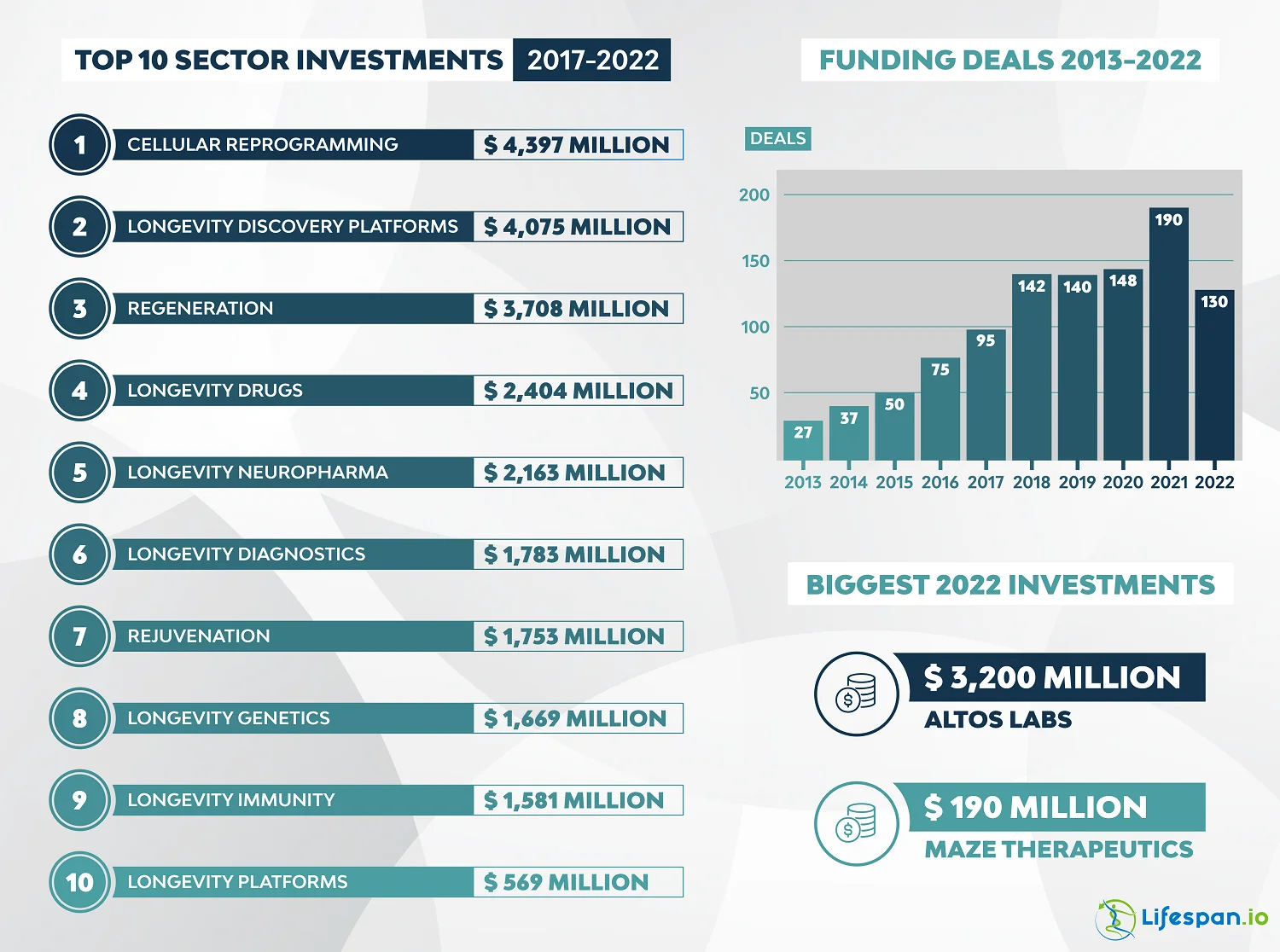2021 marked one of the biggest years in longevity financing, with 2022 following closely behind, according to a report by Longevity.Technology. Over the past ten years, the industry has grown in financing from $500 million in 2013 to a peak of $6.2 billion (2021). Despite taking a dip in 2022, investment in longevity appears to be on an overall growth trajectory, albeit one that is not immune to wider market trends.
Longevity investment trends over the past five years
2022 started on a high note with a sizable investment of $3.2 billion into Altos Labs, a life sciences company focused on cellular rejuvenation programming. This investment made up the majority of the year’s total of $5.2 billion, a dip from 2021’s peak of $6.2 billion.
In comparison, the second-largest investment of 2022 was $190 million invested into Maze Therapeutics, a San Francisco-based biotechnology company focused on translating novel genetic insights into medicines. The next top five investment deals came in between $80 to $180 million.
Although the 2022 market may seem somewhat subdued compared to 2021’s, it is considerably higher than 2020’s $3 billion, 2019’s $2.2 billion, and 2018’s $2.7 billion in longevity investments. This trajectory is similar to the rise in fintech and biotech in 2021, with a dip in 2022.
During the COVID-19 pandemic, spanning 2020 and 2021, interest in health, biotech, and fintech rose as a result of an increased focus on healthcare, medical research, and digital solutions, such as remote banking. In turn, these sectors, longevity included, showed an accelerated period of growth.
Overall, the investment curve can best be described as an S-curve, although it is not clear if this trend will continue.
Deals: types, sizes, and amounts
Although the overall numbers tell part of the picture, industry sentiment can be somewhat observed in the types of deals being made, their sizes, and their amounts.
In 2021, 190 longevity funding deals were struck, marking another industry peak; the three preceding years averaged around 143 deals per year. This is an increase from 2013 to 2017, which had between 27 to 95 deals per year. Meanwhile, 2022 indicated a decrease from 2021, with 130 deals being made in total.
Looking closer at 2022, aside from Q1’s Altos Labs deal, overall financing into longevity has held relatively steady over the year, with results of $430 million to $607 million per quarter. Despite a decrease in the number of deals being made, funding amounts have shown resilience.
Additionally, the deal size by stage is also notable. 2021 beat 2022 in later-stage venture capital, private investment in public equity, initial public offerings, seed funding, and corporate financing. Meanwhile, 2022 led in early-stage venture capital.
Breakdown of investment categories
Cellular reprogramming comes out on top in investor interests, amounting to deals worth $4,397 million in the last five years. However, this is partially due to Altos Labs’ $3.2 billion investment. The infographic below gives an overview of investments and funding deals in recent years.

- Cellular reprogramming ($4,397 million) aims to reverse cell aging and transform an older cell into its younger state.
- Longevity discovery platforms ($4,075 million) aim to find a solution to the expensive and extensive process of scientific funding and development.
- Regeneration ($3,708 million) focuses on the natural process of replacing or restoring damaged or missing cells; these organizations seek to find a viable solution to regeneration in plant and animal cells.
- Longevity drugs ($2,404 million) are dedicated to the discovery and creation of drugs that improve the health of the population and increase longevity.
- Longevity neuropharma ($2,163 million) seeks to tackle issues related to neurological deterioration as a result of aging by developing pharmacological solutions that reduce the impact of age-related illness.
- Longevity diagnostics ($1,783 million) utilize data to track and monitor bodily changes more closely to determine factors that can improve longevity.
- Rejuvenation ($1,753 million) focuses on rejuvenating cells and bringing them to a younger state through a variety of methodologies.
- Longevity genetics ($1,669 million) studies human lifespan through a genetic lens to understand the role genetics plays in longevity and which genes are impacted.
- Longevity immunity ($1,581 million) helps improve longevity outcomes by improving the body’s defense mechanisms and immune system.
- Longevity platforms ($569 million) define any other platforms that can be used to support longevity science and outcomes.
How has sector interest shifted?
Longevity is a constantly expanding field with new innovations coming to the forefront as potential solutions emerge. Longevity discovery platforms, longevity drugs, and regeneration solutions have held top-five places two years in a row, with newcomers, cellular reprogramming, and rejuvenation gaining interest. However, this is subject to change each year, and it does not necessarily predict how the 2023 investment year will evolve.
Recent investments, such as Pfizer’s investment of $500,000 into the decentralized autonomous organization, VitaDAO, marks a vote of confidence from ‘Big Pharma’ into more innovative approaches within the longevity science sphere.
Summary
Over the past ten years, the longevity sector has experienced growth both in the number of investments and their amount, indicating an increased interest in the longevity industry and the health sector as a whole. Although 2022 experienced a drop in overall funds invested compared to the previous year, the last few years indicate an overall growth trajectory.



